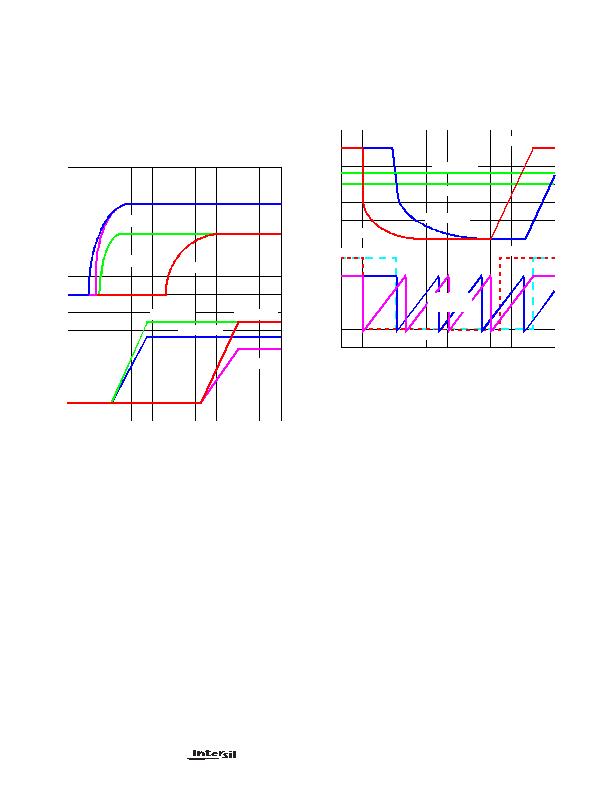
6
FN4837.5
October 16, 2006
output voltage. As the internal soft-start voltage increases, the
pulse-width on the PHASE pin increases to reach its
steady-state duty cycle at time T2. At time T3, the 3.3V input
supply starts ramping up; as a result, V
OUT2
and V
OUT4
start
ramping up on the second attempt (approximately 3.25 SS
cycles wait), at time T4. During the interval between T4 and T5,
the linear controller error amplifiers references ramp to the final
value bringing all outputs within regulation limits.
Overcurrent Protection
All outputs are protected against excessive overcurrents.
The PWM controller uses the upper MOSFETs
on-resistance, r
DS(ON)
to monitor the current for protection
against shorted output. All linear controllers monitor their
respective FB pins for undervoltage events to protect against
excessive currents.
A sustained overload (undervoltage on linears or overcurrent
on the PWM) on any output results in an independent
shutdown of the respective output, followed by subsequent
individual re-start attempts performed at an interval equivalent
to 3 soft-start intervals. Figure 2 describes the protection
feature. At time T0, an overcurrent event sensed across the
switching regulators upper MOSFET (r
DS(ON)
sensing)
triggers a shutdown of the V
OUT1
output. As a result, its
internal soft-start initiates a number of soft-start cycles. After a
three-cycle wait, the fourth soft-start initiates a ramp-up
attempt of the failed output, at time T2, bringing the output in
regulation at time T4.
To exemplify an UV event on one of the linears, at time T1,
the clock regulator (V
OUT2
) is also subjected to an
overcurrent event, resulting in an UV condition. Similarly,
after three soft-start periods, the fourth cycle initiates a
ramp-up of this linear output at time T3. One soft-start period
after T3, the linear output is within regulation limits. UV
glitches less than 1祍 (typically) in duration are ignored.
As overcurrent protection is performed on the synchronous
switcher regulator on a cycle-by-cycle basis, OC monitoring
is active as long as the regulator is operational. Since the
overcurrent protection on the linear regulators is performed
through undervoltage monitoring at the feedback pins (FB2,
FB3, and FB4), this feature is activated approximately 25%
into the soft-start interval (see Figure 2).
A resistor (R
OCSET
) programs the overcurrent trip level for
the PWM converter. As shown in Figure 3, the internal
40礎 current sink (I
OCSET
) develops a voltage across
R
OCSET
(V
SET
) that is referenced to V
IN
. The DRIVE
signal enables the overcurrent comparator (OCC). When
the voltage across the upper MOSFET (V
DS(ON)
) exceeds
V
SET
, the overcurrent comparator trips to set the
overcurrent latch. Both V
SET
and V
DS(ON)
are referenced
to V
IN
and a small capacitor across R
OCSET
helps
V
OCSET
track the variations of V
IN
due to MOSFET
switching. The overcurrent function will trip at a peak
inductor current (I
PEAK)
determined by:
The OC trip point varies with MOSFETs r
DS(ON)
temperature variations. To avoid overcurrent tripping in the
normal operating load range, determine the R
OCSET
resistor from the equation above with:
FIGURE 1. SOFT-START INTERVAL
0V
0V
TIME
+5V
SB
(0.5V/DIV)
V
OUT2
(2.5V)
V
OUT4
(1.5V)
T1
T2 T3
T0
T4
(1V/DIV)
+3.3V
IN
+5V
DUAL
+3.3V
DUAL
V
OUT3
(1.8V)
V
OUT1
(2.5V)
T5
FIGURE 2. OVERCURRENT/UNDERVOLTAGE PROTECTION
RESPONSE
0V
TIME
(0.5V/DIV.)
V
OUT3
(1.8V)
V
OUT2
(2.5V)
T1
T2
T3
T0
V
OUT4
(1.5V)
V
OUT1
(2.5V)
UV MONITORING
INACTIVE
SOFT-START
FUNCTION
ACTIVE
T4
I
PEAK
=
I
OCSET
R
OCSET
?/DIV>
r
DS ON
( )
--------------------------------------------------- -
HIP6521
发布紧急采购,3分钟左右您将得到回复。
相关PDF资料
HMC920LP5E
IC CTRLR ACTIVE BIAS 32QFN
IDTTSE2002B3CNRG
IC TEMP SENS EEPROM DFN-8
IPM6220ACAZ-T
IC REG 5OUT BUCK/LDO SYNC 24SSOP
IR2170
IC CURRENT SENSE 600V 1MA 8-DIP
IR2171STR
IC CURRENT SENSE 8SOIC
IR2172S
IC CURRENT SENSE 8SOIC
IR2175STR
IC CURRENT SENSE 0.5% 8SOIC
IR22771STRPBF
IC CURRENT SENSE 16SOIC
相关代理商/技术参数
HIP6521CBZ
功能描述:电压模式 PWM 控制器 4 IN 1 PWM/LINEAR CNTRLR 5V RoHS:否 制造商:Texas Instruments 输出端数量:1 拓扑结构:Buck 输出电压:34 V 输出电流: 开关频率: 工作电源电压:4.5 V to 5.5 V 电源电流:600 uA 最大工作温度:+ 125 C 最小工作温度:- 40 C 封装 / 箱体:WSON-8 封装:Reel
HIP6521CBZA
功能描述:IC REG QD BCK/LINEAR 16-SOIC RoHS:是 类别:集成电路 (IC) >> PMIC - 稳压器 - 线性 + 切换式 系列:- 标准包装:2,500 系列:- 拓扑:降压(降压)同步(3),线性(LDO)(2) 功能:任何功能 输出数:5 频率 - 开关:300kHz 电压/电流 - 输出 1:控制器 电压/电流 - 输出 2:控制器 电压/电流 - 输出 3:控制器 带 LED 驱动器:无 带监控器:无 带序列发生器:是 电源电压:5.6 V ~ 24 V 工作温度:-40°C ~ 85°C 安装类型:* 封装/外壳:* 供应商设备封装:* 包装:*
HIP6521CBZA-T
功能描述:IC REG QD BCK/LINEAR 16-SOIC RoHS:是 类别:集成电路 (IC) >> PMIC - 稳压器 - 线性 + 切换式 系列:- 标准包装:2,500 系列:- 拓扑:降压(降压)同步(3),线性(LDO)(2) 功能:任何功能 输出数:5 频率 - 开关:300kHz 电压/电流 - 输出 1:控制器 电压/电流 - 输出 2:控制器 电压/电流 - 输出 3:控制器 带 LED 驱动器:无 带监控器:无 带序列发生器:是 电源电压:5.6 V ~ 24 V 工作温度:-40°C ~ 85°C 安装类型:* 封装/外壳:* 供应商设备封装:* 包装:*
HIP6521CBZ-T
功能描述:电压模式 PWM 控制器 4 IN 1 PWM/LINEAR CNTRLR 5V RoHS:否 制造商:Texas Instruments 输出端数量:1 拓扑结构:Buck 输出电压:34 V 输出电流: 开关频率: 工作电源电压:4.5 V to 5.5 V 电源电流:600 uA 最大工作温度:+ 125 C 最小工作温度:- 40 C 封装 / 箱体:WSON-8 封装:Reel
HIP6521EVAL1
功能描述:电源管理IC开发工具 HIP6521 PWM & TRPL L LINEAR CNT EVAL BRD
RoHS:否 制造商:Maxim Integrated 产品:Evaluation Kits 类型:Battery Management 工具用于评估:MAX17710GB 输入电压: 输出电压:1.8 V
HIP6601
制造商:INTERSIL 制造商全称:Intersil Corporation 功能描述:Synchronous-Rectified Buck MOSFET Drivers
HIP6601_04
制造商:INTERSIL 制造商全称:Intersil Corporation 功能描述:Synchronous-Rectified Buck MOSFET Drivers
HIP6601A
制造商:INTERSIL 制造商全称:Intersil Corporation 功能描述:Synchronous Rectified Buck MOSFET Drivers